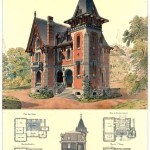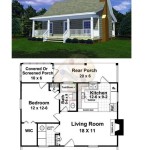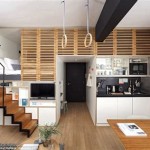One Bedroom House Design Plans: Creating a Cozy and Functional Home
Designing a one-bedroom house can be a rewarding challenge, requiring careful consideration of space utilization and functionality. While smaller in scale, one-bedroom homes can be incredibly cozy, efficient, and stylish. When planning such a home, it is crucial to prioritize functionality and maximize every square foot to create a comfortable and inviting living space. This article delves into key aspects of one-bedroom house design plans, exploring factors to consider during the design process and providing insights into effective space optimization strategies.
Understanding Space and Layout
The foundation of any successful one-bedroom house design is a well-thought-out layout. Understanding the available space and its relationship with the desired functionality is crucial. This involves careful consideration of factors such as:
- Size and Shape: The dimensions and shape of the plot or building envelope influence the overall footprint of the house and the available space for each room. Compact layouts with clever designs can maximize space.
- Orientation: The direction of the property in relation to the sun's path determines the amount of natural light received throughout the day. This influences the placement of windows, doors, and rooms for optimal natural lighting and ventilation.
- Circulation: The flow of movement within the house is essential for ease of use and functionality. This involves planning clear pathways connecting different rooms, avoiding tight spaces, and ensuring smooth transitions between areas.
By carefully analyzing these factors, designers can create a layout that maximizes utility, minimizes wasted space, and fosters a sense of flow and connection within the one-bedroom home.
Optimizing Space and Functionality
One-bedroom houses demand creative solutions for maximizing space and functionality, incorporating features that enhance efficiency and comfort. Key design considerations include:
Multi-Purpose Rooms:
One-bedroom homes often benefit from rooms that serve multiple functions. Combining living and dining spaces, kitchenettes integrated into living areas, or creating a home office within the bedroom are common design strategies. Utilizing furniture with built-in storage and creating distinct zones within a room using partitions or area rugs can help define these multiple functions.
Clever Storage Solutions:
Storage is essential in any home, but it is particularly important in smaller spaces. Built-in shelves, cabinets, and drawers can maximize storage capacity while maintaining a clean and organized look. Under-bed storage solutions, vertical wall storage, and utilizing wall-mounted organizers are effective strategies for maximizing space.
Open Floor Plans:
Open floor plans create a sense of spaciousness by minimizing visual barriers. Removing walls between the living, dining, and kitchen areas allows for more natural light and visual connectivity. This approach can make a one-bedroom home feel larger and more inviting.
Creating a Cozy and Inviting Atmosphere
While functionality is paramount, creating a cozy and inviting atmosphere is equally important in a one-bedroom home. Design strategies that enhance livability and comfort include:
Natural Light and Ventilation:
Maximizing natural light and ventilation is essential for creating a welcoming and airy space. Strategically placed windows and doors allow for ample airflow and sunlight to penetrate the interior. Using light-colored walls and furnishings can reflect light, making the space feel brighter and more spacious.
Color Palette and Materials:
The color palette and material choices play a crucial role in establishing the overall ambiance of the home. Neutral tones, such as beige, gray, and white, create a sense of calm and openness. Pops of color can be introduced through accents, furniture, and artwork, adding personality and visual interest. Natural materials like wood, stone, and textiles can add warmth and texture.
Furniture Selection and Arrangement:
Furniture selection for a one-bedroom home should prioritize functionality and comfort. Multi-functional pieces like sofa beds, ottomans with storage, and wall-mounted shelves maximize space and versatility. Arranging furniture in a way that allows for smooth traffic flow while creating distinct zones for different activities is key.
By incorporating these design elements, homeowners can transform a one-bedroom house into a cozy, functional, and stylish sanctuary that reflects their personal style and meets their individual needs.

International House 1 Bedroom Floor Plan Top View One Plans

1 Bedroom Apartment House Plans

Cozy One Bedroom House Designs And Decors

1 Bedroom Tiny House Plan

1 Bedroom Apartment House Plans Home Decoration World Small Tiny

One Bedroom House Plans Peggy

1 Bedroom House Plan Examples

Modern One Bedroom 3d Floor Plans Tsymbals Design

10 Best One Bedroom House Plans And Designs To Inspire You Co Ke

One Bedroom House Plans For Starter Homes Ck
Related Posts








